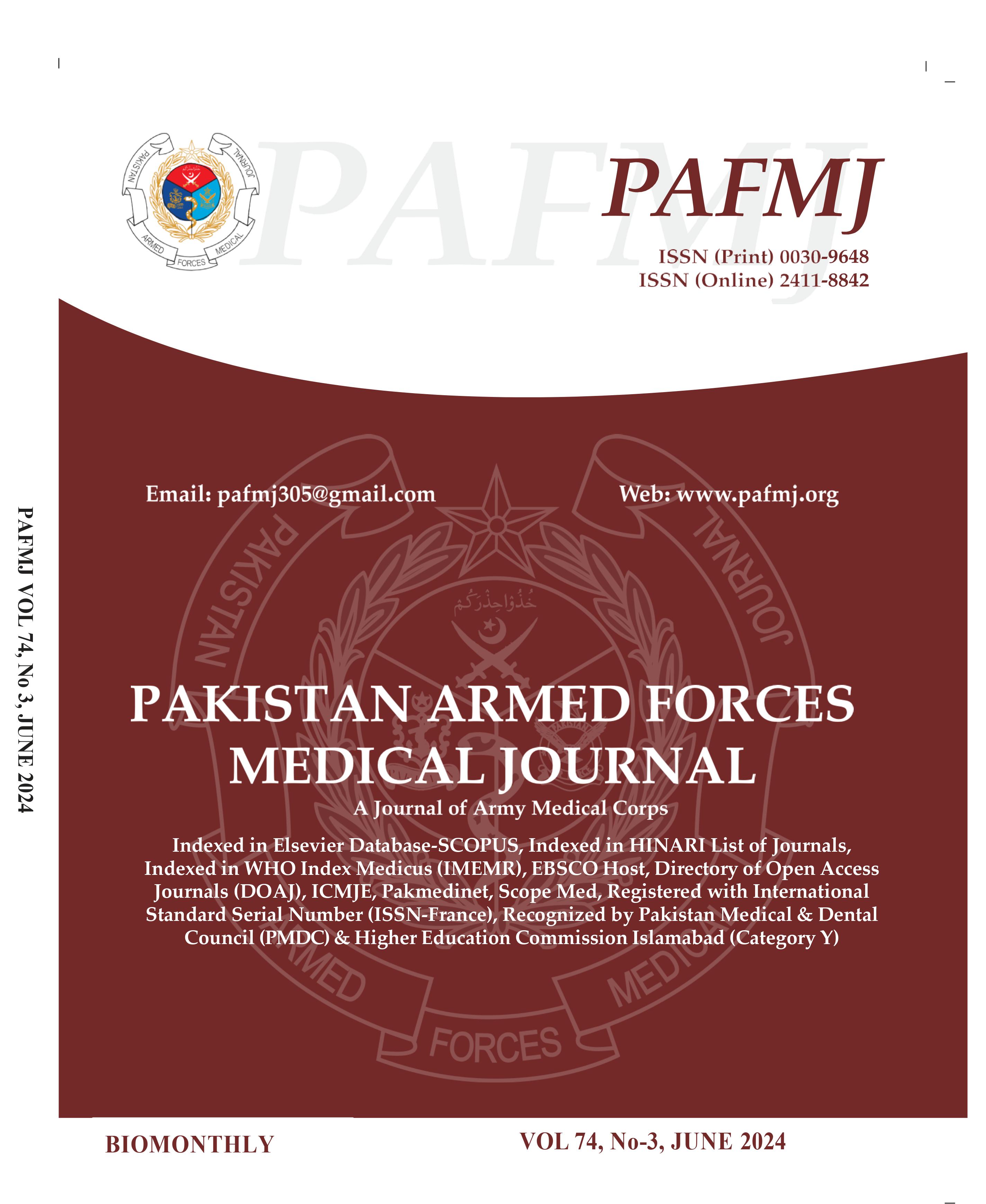Association of Age and Parity with Pregnancy-Induced Hypertension
DOI:
https://doi.org/10.51253/pafmj.v74i3.7812Keywords:
Age, Gestational hypertension, Normotensive, Parity, Pregnancy-induced hypertension (PIH).Abstract
Objective: To determine the association of age and parity with gestational hypertension.
Study Design: Case-control study.
Place and Duration of Study: Department of Gynaecology and Obstetrics, Combined Military Hospital, Sibi Pakistan, from Oct 2020 to Sep 2021.
Methodology: A total of two hundred and sixty-eight (n=268) patients (134 controls and 134 cases) were included in this study. Data about age, parity, economic status and education status was recorded. Two consecutive readings of blood pressure were recorded in sitting position, 4 hours apart, and the second reading was entered on the proforma.
Results: Mean age of the patients was 28.10±5.61 years and 28.99±6.29 years in cases and controls, respectively. Mean gestational age was 38.46±1.02 weeks in cases and 38.04±1.00 weeks in controls. In cases, primigravida were 88(65.7%) and multigravida were 46(34.3%) and in controls 58(43.3%) were primigravida and 46(56.7%) were multigravida. Odds ratio was 2.50(95% CI: 1.53-4.10), p value was <0.001. In cases, 111 women (82.8%) were from young age group and 23 women (17.2%) belonged to advanced age group. In controls 94 women (70.2%) were of young age group while 40 women (29.8%) belonged to advanced age group (p value was 0.013).
Conclusion: Primigravidae and women of younger age seem to have association with pregnancy induced hypertension
Downloads
References
Singh S, Doyle P, Campbell OMR, Murthy GVS. Management and referral for high-risk conditions and complications during the antenatal period: knowledge, practice and attitude survey of providers in rural public healthcare in two states of India. Reprod Health 2019; 16(1): 100.
https://doi.org/10.1186/s12978-019-0765-y
Meazaw MW, Chojenta C, Muluneh MD, Loxton D. Factors associated with hypertensive disorders of pregnancy in sub-Saharan Africa: A systematic and meta-analysis. PloS One 2020; 15(8): e0237476. https://doi.org/10.1371/journal.pone.0237476
Khan H, Majeed S, Hafizullah M. Peculiar risk factors and complications of Pregnancy Induced Hypertension in a tertiary care hospital of Peshawar. Pak Armed Forces Med J 2009; 59(3): 324-327
Umesawa M, Kobashi G. Epidemiology of hypertensive disorders in pregnancy: prevalence, risk factors, predictors and prognosis. Hypertens Res 2017; 40(3): 213-220
https://doi.org/10.1038/hr.2016.126
Brown MA, Magee LA, Kenny LC, Karumanchi SA, McCarthy FP, Saito S, et al. Hypertensive disorders of pregnancy: ISSHP classification, diagnosis, and management recommendations for international practice. Hypertension. 2018; 72(1): 24-43
https://doi.org/10.1161/HYPERTENSIONAHA.117.10803
Umesawa M, Kobashi G. Epidemiology of hypertensive disorders in pregnancy: prevalence, risk factors, predictors and prognosis. Hypertens Res 2017; 40(3): 213-220
https://doi.org/10.1038/hr.2016.126
Nyaga FU, Bigna JJ, Jingi AM, Nansseu JR, Kaze AD, Fokom-Domgue J, et al. Hypertensive disorders of pregnancy in Africa: a systematic review and meta-analysis. J Hypertens 2018; 36: e250-251
Parveen N, Haider G, Shaikh IA, Din UJ. Presentation of predisposing factors of Pregnancy Induced Hypertension at Isra University Hospital, Hyderabad. JLUMHS 2009 Sep 1; 8(03): 242.
Sajith M, Nimbargi V, Modi A, Sumariya R, Pawar A. Incidence of Pregnancy Induced Hypertension and prescription pattern of antihypertensive drugs in pregnancy. Int J Pharma Sci Res 2014; 23(3): 4.
Khosravi S, Dabiran S, Lotfi M, Asnavandy M. Study of the prevalence of hypertension and complications of hypertensive disorders in pregnancy. Open J Prev Med 2014; 4(11): 860. https://doi.org/10.4236/ojpm.2014.411097
Gudeta TA, Regassa TM. Pregnancy Induced Hypertension and Associated Factors among Women Attending Delivery Service at Mizan-Tepi University Teaching Hospital, Tepi General Hospital and Gebretsadik Shawo Hospital, Southwest, Ethiopia. Ethiop J Health Sci 2019; 29(1): 831-840.
https://doi.org/10.4314/ejhs.v29i1.4
Tessema GA, Tekeste A, Ayele TA. Preeclampsia and associated factors among pregnant women attending antenatal care in Dessie referral hospital, Northeast Ethiopia: a hospital-based study. BMC Pregnancy Childbirth 2015; 15(1): 1-7.
https://doi.org/10.1186/s12884-015-0645-5
Kalim N, Anwar I, Khan J, Blum LS, Moran AC, Botlero R, et al. Postpartum haemorrhage and eclampsia: differences in knowledge and care-seeking behaviour in two districts of Bangladesh. J Health Popul Nutr 2009; 27(2): 156.
https://doi.org/10.3329/jhpn.v27i2.3312
Ayaz A, Muhammad T, Hussain SA, Habib S. Neonatal outcome in pre-eclamptic patients. J Ayub Med Coll 2009; 21(2): 53-55.
Saadat M, Nejad SM, Habibi G, Sheikhvatan M. Maternal and neonatal outcomes in women with preeclampsia. Taiwan J Obstet Gynecol 2007; 46(3): 255-259
https://doi.org/10.1016/S1028-4559(08)60015-5
Kashanian M, Baradaran HR, Alimohammadi R. Risk factors for pre-eclampsia, a study in Iran. J Hypertens 2010; 28(3): e191.
Aimukhametova G, Ukybasova T, Hamidullina Z, Zhubanysheva K, Harun-Or-Rashid M. The impact of maternal obesity on mother and neonatal health: study in a tertiary hospital of Astana, Kazakhstan. Nagoya J Med Sci 2012; 74(1-2): 83
Barden AE, Beilin LJ, Ritchie J, Walters BN, Graham D, Michael CA. Is proteinuric pre-eclampsia a different disease in primigravida and multigravida? Clin Sci 1999; 97(4): 475-483.
https://doi.org/10.1042/cs0970475
Ødegård RA, Vatten LJ, Nilsen ST, Salvesen KÅ, Austgulen R. Risk factors and clinical manifestations of pre‐eclampsia. Int J Gynaecol Obstet 2000; 107(11): 1410-1416.
https://doi.org/10.1111/j.1471-0528.2000.tb11650.x
Garovic VD, White WM, Vaughan L, Saiki M, Parashuram S, Garcia-Valencia O, et al. Incidence and long-term outcomes of hypertensive disorders of pregnancy. J Am Coll Cardiol 2020; 75(18): 2323-2334. https://doi.org/10.1016/j.jacc.2020.03.028
Hauspurg A, Parry S, Mercer BM, Grobman W, Hatfield T, Silver RM, et al. Blood pressure trajectory and category and risk of hypertensive disorders of pregnancy in nulliparous women. Am J Obstet Gynecol 2019; 221(3): 277.e1-277.e8.
https://doi.org/10.1016/j.ajog.2019.06.010
Khashan AS, Evans M, Kublickas M, McCarthy FP, Kenny LC, Stenvinkel P, et al. Preeclampsia and risk of end stage kidney disease: A Swedish nationwide cohort study. PLoS Med 2019; 16(7): e1002875.
https://doi.org/10.1371/journal.pmed.1002875
O’Gorman N, Wright D, Syngelaki A, Akolekar R, Wright A, Poon LC, et al. Competing risks model in screening for preeclampsia by maternal factors and biomarkers at 11-13 weeks gestation. Am J Obstet Gynecol 2016; 214(1): 103.e1-103.e12. https://doi.org/10.1016/j.ajog.2015.08.034
Downloads
Published
Issue
Section
License
Copyright (c) 2024 Abida Ashraf, Samina Hameed, Yasmin ., Mansoor Ahmad, Muhammad Zeeshan Saleem, Ijaz Ahmed

This work is licensed under a Creative Commons Attribution-NonCommercial 4.0 International License.















